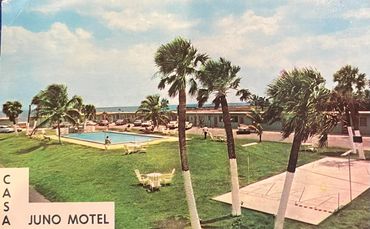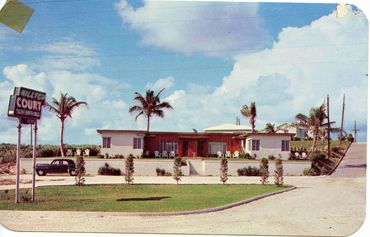The Motel Era of the 50s-80s
Following the end of World War II, prosperity, wider automobile ownership, and better highways led to a boon in family road trips. With its unique coastal location, Juno Beach became a motel enclave. This situation changed dramatically in the 1980s, however.

Beachbound was a set of colorful, high-end vacation cottages on Celestial Way.
Stanley Kagan, Juno Beach's longest serving mayor, designed this when he moved here with his family in 1949.
They featured amenities such as a salt-water pool, games room with a television, and air conditioning.
He later sold them as individual private residences, which they remain today.

The Surf Grill stood opposite the Surf Cottages.
Both surf fishing and fishing from the new Fishing Pier were major draws for anglers visiting Juno Beach.
If their many other offerings weren't enough to draw you in, the Wallaces boasted that: "The most beautiful fish mounts in Florida are displayed in our Trophy Room."

Juno by the Sea was built in the late 1940s. Ocean Drive was still US 1 and, being the Atlantic coastal highway, traffic was heavy.
Crossing the road in the season was a challenge. This motel created a unique underground tunnel giving its patrons safe and direct beach access.
The tunnel is still open today, and the remaining right side of the building is used by the county lifeguards.

Ocean Drive in Juno Beach remained US 1 and the main East Coast highway until 1957.
Because the federal government feared this crucial artery might be washed out in a hurricane, they made US 1 an inland bypass. Ocean Drive was then renamed A 1 A.
Since tourists might now avoid Ocean Drive, the local motel owners had this sign erected to steer them westward once they reached Jupiter.

Motel sites abounded. Ocean Drive in Juno Beach was unique in being the only stretch of Federal Highway directly on the Atlantic shoreline.
By the 1960s, and with the prevalence of automobile ownership and family road trips, these businesses flourished. There were as many as 17 motels here at one time.
Some of today's condominiums adopted the names of former motels.
==>Tour tab
More Motels. Row 1--Casa Juno, Juno Beach Motel, Ocean Lodge. Row 2--Seaview, Hilltop Court, Sapphire Sea. Row 3--Ocean Terrace, Malbo, South Seas









Yogi by the Sea was a vast RV park in the Ocean Terrace area as this aerial view shows. It was even a KOA campground for a while.
Though we refer to this period as the Motel Era, there were and still are many RV and mobile home residents in Juno Beach, especially in the winter season.

Howard Johnson's was the first national hospitality chain in Juno Beach when it opened in 1960.
The restaurant was famous for its 28 flavors of ice cream. This one even offered "le Beef Burgundy" ($1.95) for "a little bit of Paris" in a 1967 ad.
These buildings at Donald Ross Rd. and US 1 remain: the one is the Juno Beach Fish House and the other is the Holiday Inn.


"Service Station" is rarely applied to gas stations today like the Shell on US 1 that now stands on this site.
When you pulled in at that time, you could just tell the attendant "Fill 'er up" and, if you wanted, "Check the oil, too." Air and road maps were free. You paid in cash. No convenience store, though.
This 1960 Gulf was a working repair garage and even had a bay for hand car washes.

The Fishing Pier, built in 1949, was popular with anglers of all ages.
By the Eighties, the pier's steel infrastructure had corroded badly. Its central section collapsed in a storm in 1986.
Then-owner Penny Sheltz and scores of passionate supporters lobbied the Town to take over the project but without success.
Courtesy HSPBC

The Juno Ball was the Seminole Golf Club's water tower from 1959 to 1981.
Looking like a golf ball atop a tee, and at a height of 135 ft., it was a local landmark. Offshore anglers used it as a marker for the best fishing site.
Its 25-foot-wide tank was built to withstand winds over 160 MPH. It was also a backup water supply for the town for awhile until salt water began to intrude the aquifer.

Town Hall opened in 1961 eight years after its incorporation. This former gas station was reconfigured to create offices, a council chamber, and police base.
Until then, Commission meetings were held in various motels; the Town Clerk did business from a table in a coffee shop.
This site is now Town Hall Park. The modern Town Center opened in 1992.
Watercolor by Helen Shick.
==>Tour tab

The Greenbrier, opening in 1966, was the first condominium in Juno Beach.
Mayor Stanley Kagan, owner of the adjoining Beachbound cottages, created this, the Colony and the Seminole condos.
The concept of condominium ownership was still relatively novel for most Florida visitors. Developers facilitated purchases by arranging favorable mortgage terms.
==>Tour tab

The Tower in 1972 was the town's first high-rise.
By the 1980s, motels were being replaced by condominiums. As coastal property values—and their taxes—soared, oceanfront motels were no longer sustainable businesses.
Buildings had been limited to three stories in the original area south of the Brigadoon. As the town expanded and annexed new areas, the Council decided to allow them to rise to 12.

Our two Natural Areas almost weren't!
In 1978, the Town Council approved a developer's plan to build a dozen 12-story buildings on the natural area north of Donald Ross Rd. Phase II would be 1200 units on the tract west of US 1.
The backers withdrew only due to an economic downturn.
County voters passed a bond issue in the late-90s permitting the purchase of our unique conservation lands.